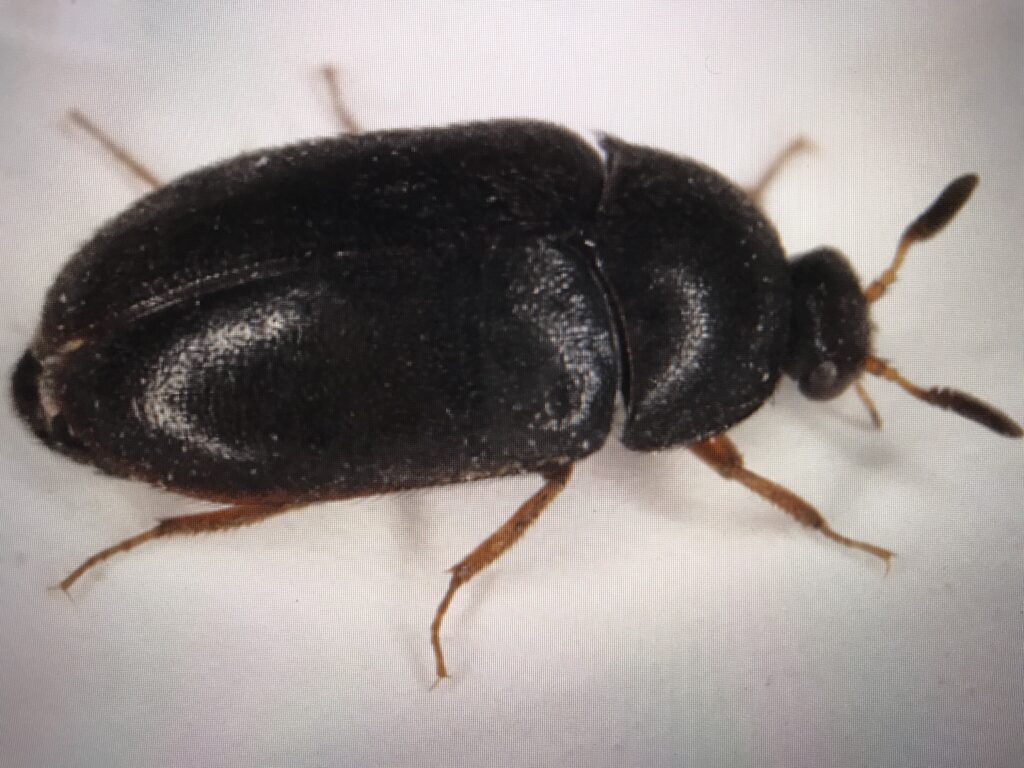Appearence of Larder Beetles
Size- Adult larder beetles are 1/4 to 1/3 inches in length.
Appearence- Larder beetles are dark brown with a light yellow band across the upper end of their wing covers.
Features- Larder Beetles are oval in shape with 6 limbs.

Appearence of Larder Beetle “Larva”
Size– Larder beetle larvae are about ½ inch in length.
Appearance– They have two curved spines on the upper side of the last visible boy segment.
Features– Larder larvae are covered with sporadic with long stiff yellowish hair.

Identification
Other names for larder beetles Larder beetles are members of the beetle group called dermestid beetles. Larder beetles also known as dermestid beetle/dermestidae, skin beetles, carpet beetles, khapra beetles, hide or leather beetles are very destructive to animal trophies and taxidermy mounts.
Food Source- Larder beetles search for food high in protein. Stored foods are another problematic area where homeowners can find larder beetles.
What attracts larder beetles?
Larder beetles feed on jerky, dry pet food, dead mice, or other mammals that have died in wall voids, attics, or garages. They can cause damage to taxidermy or animal trophies at this stage of their life.
How to get rid of larder beetles
- Locate Infestation- Locate larder beetles and larvae infestations (normally in taxidermy, animal trophies, animal food, hides, foods high in protein, dead rodents/animals, garbage).
- Discard- Remove and discard any items that are infested with larder beetles.
- Apply Pesticides- If you cannot discard items such as taxidermy/animal trophies, put them aside. Apply a residual pesticide made for taxidermy to animal trophies. Follow the label to insure sure you do not damage taxidermy and to ensure your safety.
- Treat Infested Area- After infested items are removed from area, apply a residual pesticide labeled for the infested site. Follow the instructions on the label to ensure your safety.
How to get rid of larder beetles in kitchen cabinets and storage closets
- Remove Items- Remove all food, dishes, items from cabinets (or infested areas).
- Application- Apply a residual insecticide as directed on the label. Follow instructions to ensure safety.
- Let Pesticides Dry- All treated surfaces should be covered with shelf paper after insecticides have dried. The shelf paper will ensure that insecticides don’t come into contact with food, dishes, or other items.
How did I get larder beetles?
Larder beetles enter homes through open doors or cracks in walls during the late summer and fall to escape cold weather. They nest near food sources, particularly in kitchen pantries. Like many other bugs they are attracted to lights.
How do i get rid of larder beetles naturally
the type of treatment will depend on where you are seeing or having larder bug problems. Many people in Alaska who hunt will find larder bugs destroying their animal trophies/taxidermy.
- Find Problem Areas: *Larder beetles feed on leather so check animal trophies, fur coats, leather coats. *Larder beetles also feed on human and pet food so throw away any infested food. *Animal nest especially bird nests are a target area for larder beetles. *Garage and storage rooms are prime location to find larder beetle harbor stations
- Throw Away-discard infested food and infested items that you aren’t going to treat. Discard any trash in the home.
- Vacuum-Vacuum kitchen shelves and carpet in home. This will help remove eggs and larvaes of larder beetles
- Storage– store all food in seal tight containers so that larder bugs cannot feed and lay eggs on food.
Larder Beetle
Black Larder Beetle

Appearance– Black larder beetles are the same shape and size as regular larder beetles but they don’t have a light-yellow band across their upper wing covers.
How to treat black larder beetles- Black Larder beetles are related to the larder beetle. They can be exterminated by applying a residual pesticide to areas in your home where they are active. Black larder beetles like to hide in cracks and crevices. Appling a residual pesticide to cracks and crevices is necessary. Be sure to vacuum to eliminate eggs and larvae that may be living in your carpets.
Hide Beetles

Hide beetle appearance– Hide beetle size and appearance are remarkably similar to larder beetles. They can be black or dark brown and are covered with sporadic yellow hairs that look like yellow dots.
Hide beetle larvae appearance- Hide beetle larvae are almost undistinguishable in appearance to the larder beetle larvae.
Hide beetle larvae destructive nature– Hide beetle larvae can be very destructive to homes. They have a strong tendency to burrow into wood and other building materials such as foam insulation. They can cause so much damage to buildings to the point where the structural integrity of the home or building can be compromised.
How to treat hide beetles and their larvae- When hide beetle infestations are present, tarping and fumigation is required. This can be a dangerous endeavor that can be conducted safely by a professional.

